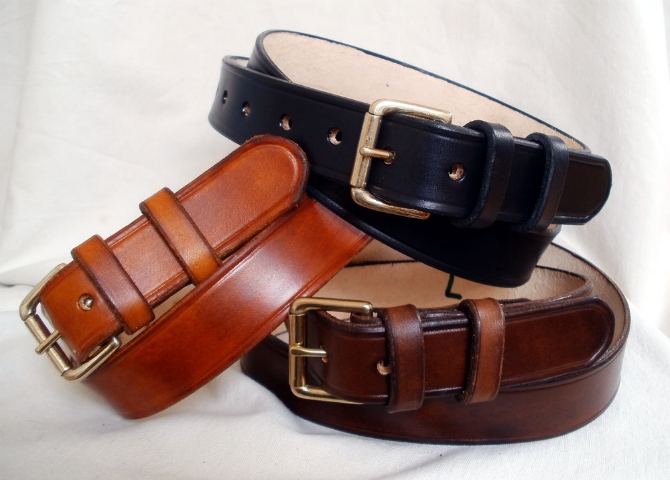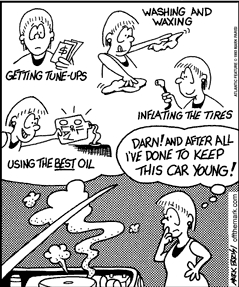Posted on 3/22/2011
Bad air quality while you're driving around is nothing to sneeze at. But seriously, more and more vehicles these days come equipped with a car air filter. Since they're fairly new on the scene, a lot of folks don't know about them yet. These filters clean the air in the passenger compartment, or cabin, of your car or truck. They do the same job as the furnace filter you have at home. They can filter out particles as small as thee microns. By contrast, a grain of sand is about 200 microns. So your cabin air filer can clean out dust, pollution, pollen and spores, to keep the air in your car nice and clean. And just like your furnace filter, they need to be replaced when they get dirty. Check your owner's manual, but they typically need to be replaced at around twelve to fifteen thousand miles. The filter is usually either under the hood or under the dashboard. Some are a little tricky to get to, so you'll want ... read more
Posted on 3/16/2011

With high fuel prices in San Diego comes lots of gas saving advice. Some of it is really great. Some is myth. And some is just designed to prey on people desperate to save some money on gas. When you get one of those e-mails that's going around telling you how to save gas, try to think it through. Does it really make sense? Does it defy the laws of physics? Do some research on the internet or ask your San Diego service advisor at Convoy Auto Repair. There aren't any magic pills you can drop in your gas tank and the government hasn't suppressed a device you can clamp on your fuel line to make your car run on air. Not even in San Diego! So next time you get one of those e-mails, check it out with an automotive professional. You'll get more bang for your buck with an car oil change or an engine air filter replacement. We're Convoy Auto Repair ... read more
Posted on 3/15/2011

Spring is in the air in San Diego! With longer days and warmer weather, we have some great suggestions on how to enjoy your week; from film festivals to St. Patrick’s Day celebrations, and some free family art fun, this week is sure to be a busy one! The 18th annual San Diego Latino Film Festival is happening now through Saturday, March 20th in San Diego. It features 185 documentaries, feature films, animations and shorts - as well as parties, talks with he filmmakers, and more. The festival is being held at UltraStar Mission Valley Cinemas and tickets are still available for purchase. General admission tickets are $10 or you can purchase a $90 film pass, which includes entrance to 11 films, no waiting in lines, and VIP seating. Support the local arts a ... read more
Posted on 3/10/2011

Every vehicle that has a timing belt will require a timing belt replacement at some point during its life. Knowing the signs of a failing belt can help drivers ensure their vehicle receives the maintenance it needs before serious issues arise. Five signs indicating the need for a timing belt replacement include: 1) Fraying or wear on the belt itself. Once the belt starts to crack and split, it is time to have it replaced. 2) Missing teeth. On older vehicles, timing chains rather than belts were used and if any of the metal teeth are missing or broken, a new belt or chain should be installed. 3) Poor fuel economy. A timing belt regulates the timing of engine gears, and if it is not doing its job correctly, will result in odd fuel use patterns. 4) A lack of power. If stepping on the accelerator results in intermittent or low power, a frayed timing belt may be the cause. 5) Mileage. Most manufacturers recommend a ti ... read more
Posted on 3/9/2011
All modern vehicles come with fuel injection systems, so it’s a topic we all need to know something about. All new cars and trucks sold over the last 30 years or so have come with fuel injection systems. The fuel injector is a valve that delivers the gas or diesel fuel to the right place, in the right amount, at the right time; to be mixed with air and burned in the engine. So how many fuel injectors does your car have? There’s one for each cylinder. So four, six or eight for most folks. Some vehicles have 10 or 12 cylinders. The engine control computer makes adjustments to the fuel injector as it monitors the engine and other sensors. Fuel injectors are a pretty sophisticated part. Convoy Auto Repair can help you with a fuel injector cleaning service. What’s the benefit? In order to work right, the fuel injectors have to deliver the fuel at a precise pressure at a very precise time. The fuel needs to be sprayed in a particular pattern as determined by the engine design. Over time, va ... read more
Posted on 3/2/2011
Today at Convoy Auto Repair we want to talk with you about a very important safety issue. This automotive safety warning is coming from a very unusual source: fire fighting experts. You’ve probably heard of E-85 gasoline being offered in the San Diego area. Some newer vehicle models are specifically built to run on E-85 – the rest are not. E-85 gasoline has been developed to fight air pollution and reduce oil consumption. E-85 fuel is a mix of 85% ethanol, a grain-base alcohol, and 15% gasoline. So-called Flex-Fuel vehicles are designed to use either normal gasoline or E-85 gas. The result is lower harmful exhaust emissions to our local community. All gas engines can run with up to 10% ethanol and in fact a lot of gasoline sold in the San Diego area does contain some ethanol. The problem comes when well meaning people without Flex Fuel certified vehicles put E-85 into the tank. At a 15% concentration, the potential for problems arise ... read more
Posted on 2/28/2011

This week, we are all about shows happening around San Diego; kick off the week with a free movie screening, followed by a live rock show in the middle of the week, and then round up your weekend with a delightful musical, Jane Austen-style. Forget drive in movies; in San Diego, it’s all about the “dive in”! The Pearl Hotel in Point Loma offers a free weekly poolside movie screening. The films are projected onto a 10x13 foot projection screen with full sound, overlooking their beautiful swimming pool. Showtime is always 8pm, food is served from the adjoining restaurant until 10pm, and the bar stays open until 11pm. All theater seating is first come, first serve, unless your party includes 6 people or more, in which case you can reserve a cabana for dinner. The swimming pool is open to non-hotel guests with the purchase of a beverage from the bar. March is J ... read more
Posted on 2/23/2011
There was a man who learned that most car accidents occur within a mile of home – so he moved. (Just Kidding!) When we think of defensive driving, we often focus on our local highway situations. The fact of the matter is we need to be just as careful close to home in San Diego, because that's where we do most of our driving. We can't let our familiar surroundings keep us from driving defensively. Defensive driving begins with the proper attitude. Have in mind that you won't let anyone take your safety away from you. You'll be aware of your surroundings, road conditions, other vehicles and hazards. And the first person to be concerned with is you: start with your own environment. Don't leave without securing all occupants including children and pets. Watch for loose items that can become projectiles during evasive maneuvers. Driving too fast or too slow increases the chance of an accident. Never drive impaired: Alcohol is a factor in half of all fatal crashes. Never dr ... read more
Posted on 2/22/2011

Regular auto maintenance is a key component in keeping a car running as well as possible for the longest period of time. One of the most important, routine auto maintenance services that an auto body shop can provide is a basic tune-up. A basic tune-up involves a number of procedures that are all aimed at preventing more serious problems from occurring. During a tune-up, the air filter in a vehicle should be checked and replaced if needed in order to ensure that adequate air is getting to the fuel supply for it to function properly; the spark plugs, rotor and distributor cap should all be inspected; and the fuel filter, spark plug wires and oxygen sensor all examined. In addition, a basic tune-up may include a radiator or coolant flush as well as topping off fluid levels for both windshield wipers and power steering. By performing regular auto maintenance and having a tune-up done at least once a year, a car owner can ... read more
Posted on 2/17/2011
The price of gas has got everyone talking. It seems that people who need a bigger vehicle to carry family and gear, or provide four wheel drive, are especially hit hard. That is why we thought it would be good to review some things that anyone can do to improve fuel economy. First let's start with how we drive. People may not realize that they can really save on gas by just changing a few driving habits. One of the biggest is jackrabbit starts - you know, flooring the gas as soon as the light turns green. That really wastes a lot of fuel. Building up your speed at a slower pace uses less fuel and is easier on your engine and drive train. And don't drive with one foot on the brake. That's also a drag on fuel economy, and it wears out your brakes faster too. Another thing is to drive slower - but only when it's safe. Sometimes on the highway we drive an extra five ... ten . . . twenty ... over the speed limit. We do it to save time, but it only sav ... read more